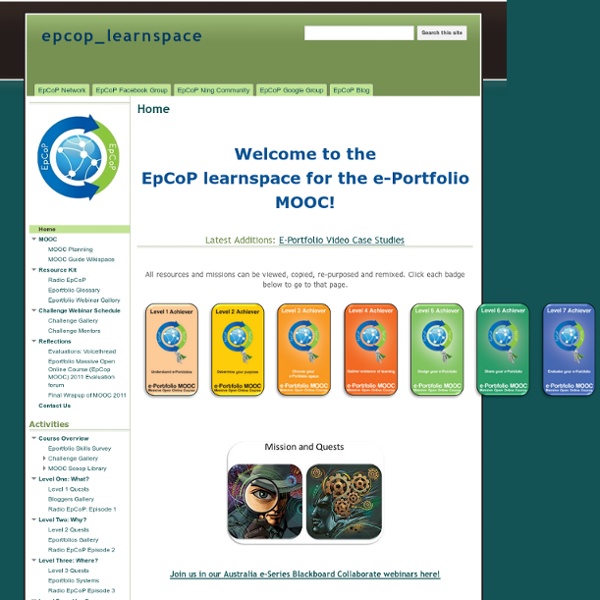Epcop_learnspace
Do you want to know all about eportfolios? Then join us here in this Massive Open Online Course (MOOC) and experience the What, Why, How, Where, So What, Now What and Then What of creating and reflecting in Eportfolios! The learnspace is a library, a resource kit, a gallery, a classroom, and a communication portal - a space for participants to learn collaboratively about Eportfolios. The learnspace has also provided a space for the EpCoP design team to discuss, select and gather relevant resources, activities, communications and networks that are structured to help practitioners to build an awareness of the power of Eportfolios and to develop the Massive Open Online Course (MOOC) for: VET practitioners developing a professional e-portfolio to support their CPD needs (eg industry and professional currency)
e-portfolios
Baranduda Blog
eFolio in the UK and Europe
Research on Electronic Portfolios in Teacher Education
Electronic Portfolios in Teacher Education Neal Strudler, University of Nevada Las Vegas Keith Wetzel, Arizona State University This site was created to distribute research information and findings from our study on the use of electronic portfolios in teacher education programs. During the first phase of the research, we identified teacher education programs in which e-portfolios were well-articulated, mature, and implemented program-wide for a minimum of two years. Findings from the study are being released to address research questions such as... What was the situational and historical context in which electronic portfolios were adopted and implemented? What do the various facets of the electronic portfolio process look like as implemented? What are the benefits and costs of electronic portfolios as perceived by the various stakeholders? Are the perceived benefits worth the investment for teacher education programs? What are the “next steps” envisioned for the electronic portfolio programs?
Reflective practice
Reflective practice can be a beneficial process in teacher professional development, both for pre-service and in-service teachers. This digest reviews the concept, levels, techniques for, and benefits of reflective practice. Refining the concept In 1987, Donald Schon introduced the concept of reflective practice as a critical process in refining one's artistry or craft in a specific discipline. More recently, Boud and Walker (1998) also noted shortcomings in the way SCDEs were applying Schon's concept of reflective practice to teacher education. Reflective practice has also been defined in terms of action research. Levels of reflective practice Reflective practice is used at both the pre-service and in-service levels of teaching. At the level of in-service teaching, studies have shown that critical reflection upon experience continues to be an effective technique for professional development. References: Boud, D. & Walker, D. (1998). Clarke, A. (1995). Freidus, H. (1997). Hopkins, C.
E-portfolios blog » Blog Archive » “Implementing E-portfolios” EpCop Webinar
Following on from the very successful series of webinar’s from E-portfolios Community of Practice Massive Open Online Course (EpCop MOOC) , EpCop presents the final free webinar for 2011 on ‘ Implementing E-portfolios ‘. Drawing on the experience of two organisational implementation processes from Sunshine Coast TAFE (Qld) and Box Hill Institute (Vic) , this webinar will showcase the challenges and opportunities when undertaking the: selection process for deciding on an organisation wide e-portfolio system by Kathryn Rodney, Sunshine Coast TAFE strategtic roll out of an e-portfolio system to support individual learning plans by Pauline Farrell, Box Hill Institute The free webinar will take place on Tuesday 8 November at 11 am Australian Eastern Daylight Saving Time ( Time Converter here ) using the Australia e-Series Blackboard Collaborate: Share your implementation/strategic roll out experiences here.
LEAP2A
RFC 4287 - The Atom Syndication Format
[Docs] [txt|pdf] [draft-ietf-atompu...] [Diff1] [Diff2] [IPR] [Errata] Updated by: 5988 PROPOSED STANDARD Errata Exist Network Working Group M. Nottingham, Ed. Request for Comments: 4287 R. Sayre, Ed. RFC 4287 Atom Format December 2005 4.2.4. RFC 4287 Atom Format December 2005 1. Atom is an XML-based document format that describes lists of related information known as "feeds". 1.1. A brief, single-entry Atom Feed Document: <? RFC 4287 Atom Format December 2005 1.2. The XML Namespaces URI [W3C.REC-xml-names-19990114] for the XML data format described in this specification is: For convenience, this data format may be referred to as "Atom 1.0". 1.3. This specification describes conformance in terms of two artifacts: Atom Feed Documents and Atom Entry Documents. RFC 4287 Atom Format December 2005 2. This specification describes two kinds of Atom Documents: Atom Feed Documents and Atom Entry Documents. 3.
Related:
Related:



